Wingers can often be the difference maker for clubs in varying scenarios, from battling relegation to challenging for titles. Styles of play vary – we have the tricky, skilful winger who uses flair as the centre of their game; classic, traditional wingers who look to run with the ball before whipping a cross in, and players who operate slightly deeper – a wide playmaker essentially. Scoring goals, creating goals, link-up play, accelerating build-up phases, and more, the winger position is often one that brings a lot of hope and excitement to fans.
The EFL League Two has a host of talented players throughout the division, in all positions. In this article, we are putting a microscope on its wide players. In this data analysis, we will use various statistics to provide an in-depth analysis of a range of wide players from League Two.
The data in question will analyse areas such as dribbling, passing, goal involvements, and more, and will include one player from each of the 24 League Two clubs. Wide players have been hand-picked with minutes played and assists being the main considered factors – we have basically tried to select the best wide player from each club. In some cases, we have had to improvise and use wing-backs for teams that deploy a formation that only has wide players coming from full/wing-back – like 5-3-2 for example. We will be using data from the 2022/23 EFL League Two only.
Goal involvements
Whether or not wingers/wide midfielders are considered depends on the system and shape deployed by their club, but they are still judged on their goal involvements – if a wide player fails to contribute with goals or assists, questions are quickly asked of them. This segment will look at the assists and goals for each player so far this season.
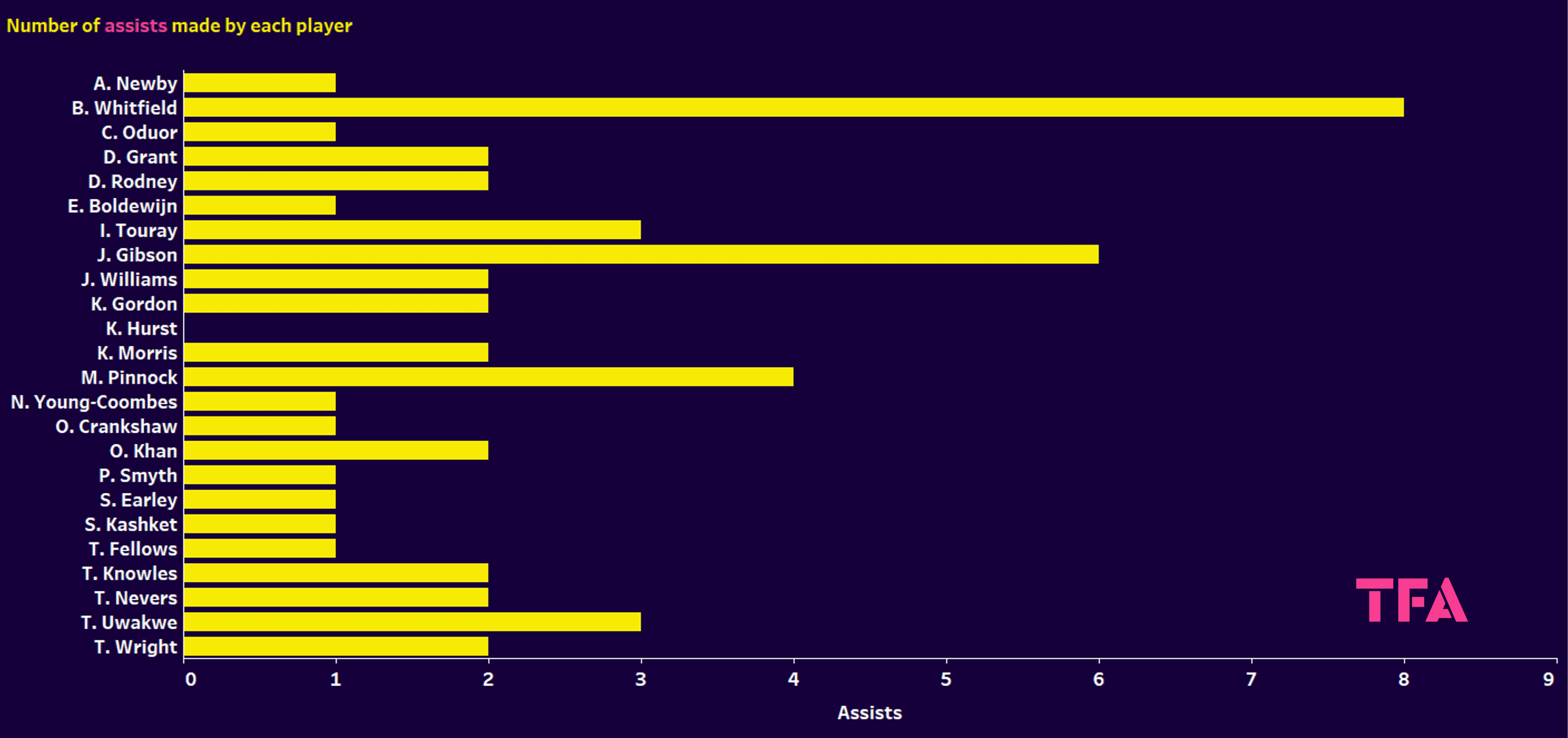
Immediately, one name jumps out with an impressive eight assists to his name already, and this is Ben Whitfield of Barrow, who have enjoyed a successful start to the season which leaves them in 5th place, scoring 24 goals. It is quite remarkable for one player to have created a third of their team’s goals.
Jordan Gibson of Carlisle has also impressed in this area, racking up six league assists at the time of writing, helping his team put themselves in the playoff picture. Mitch Pinnock of Northampton Town has a respectable tally of four assists and will certainly back himself to continue to increase that number.
There are some players, including players who are not in this analysis, who will be desperate to improve in the area of assists. The obvious one on this list is Doncaster Rovers winger Kyle Hurst, who, according to Wyscout data, is yet to register a league assist this season.
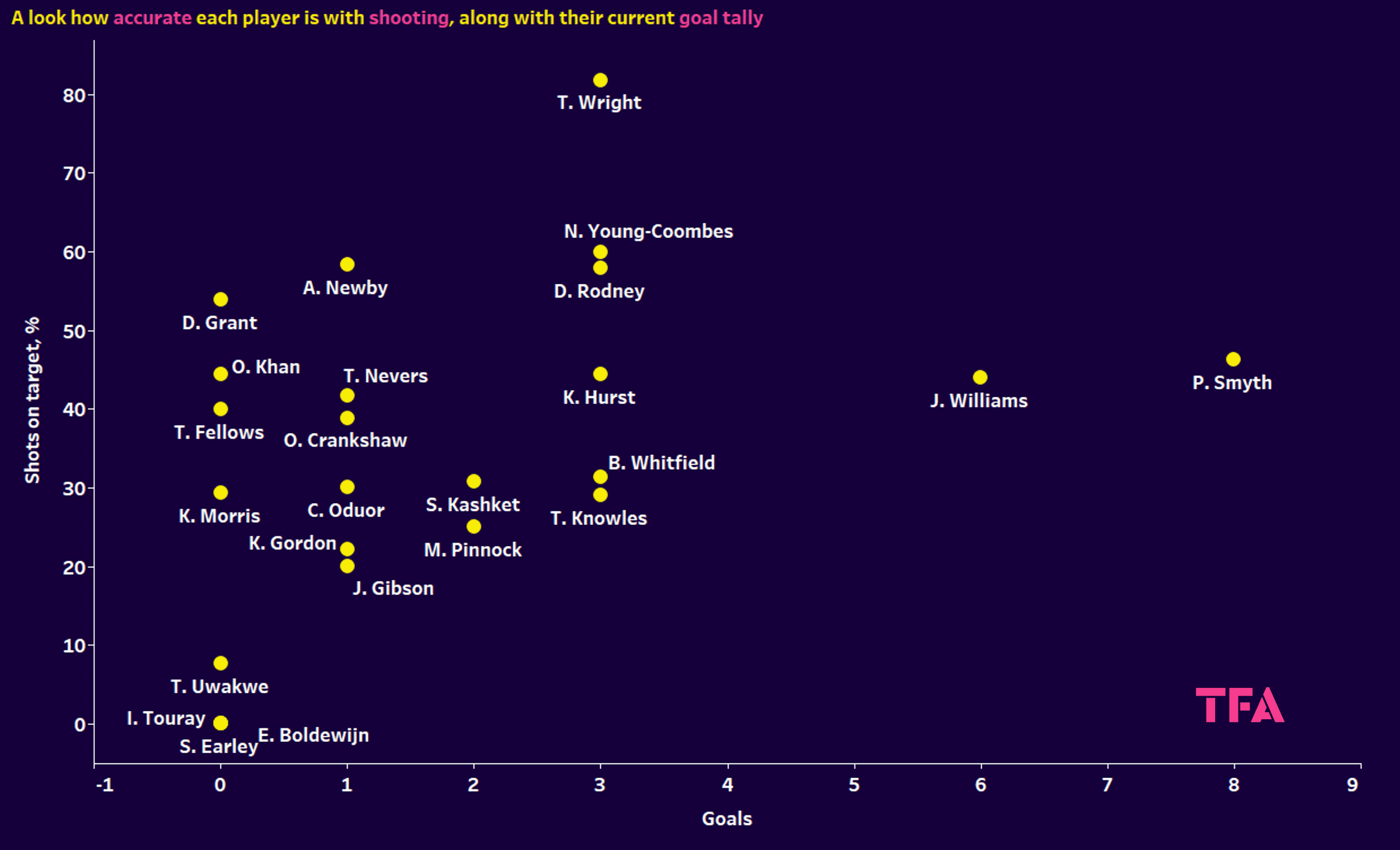
This graph allows us to get an idea of how clinical each player is in front of goal. Scoring goals is just as important as setting them up for attacking wide players and can sometimes be a team’s main source of attacking threat. The top scorer on the list is Leyton Orient’s Paul Smyth, who has enjoyed a blistering start to the season, scoring eight goals so far. His goals have given him the confidence to excel in other areas, which will become apparent later in the analysis. His shots-on-target rate of 46.34% sees him land around the middle of the pack.
Jonny Williams of Swindon Town has also started the season brightly, bagging six goals – the former Crystal Palace man has Premier League experience and has been an important figure for his current club, playing on either flank throughout the campaign. Williams has displayed average consistency with his shot accuracy rate of 44%.
One player who has bagged a few goals but will feel he should have more is Tyreik Wright of Bradford City. The 21-year-old has netted three times so far but has an astonishing shot accuracy rate of 81.82% from his eleven shots this season. This indicates that he is doing something right but either needs to find a slightly more clinical edge or just needs better luck against goalkeepers!
It is also interesting that players who were mentioned in the assists analysis but on opposite ends of the scale (Hurst and Whitfield) both have three goals to their names.
On the ball
The ability to carry the ball or retain it under pressure are both incredibly important attributes a winger can have, as the use of these skills can result in a goal-scoring opportunity for their team. Dribbling/being gifted with the ball at their feet is arguably the most important trait a winger can have, and this segment provides statistics of each player in these areas.
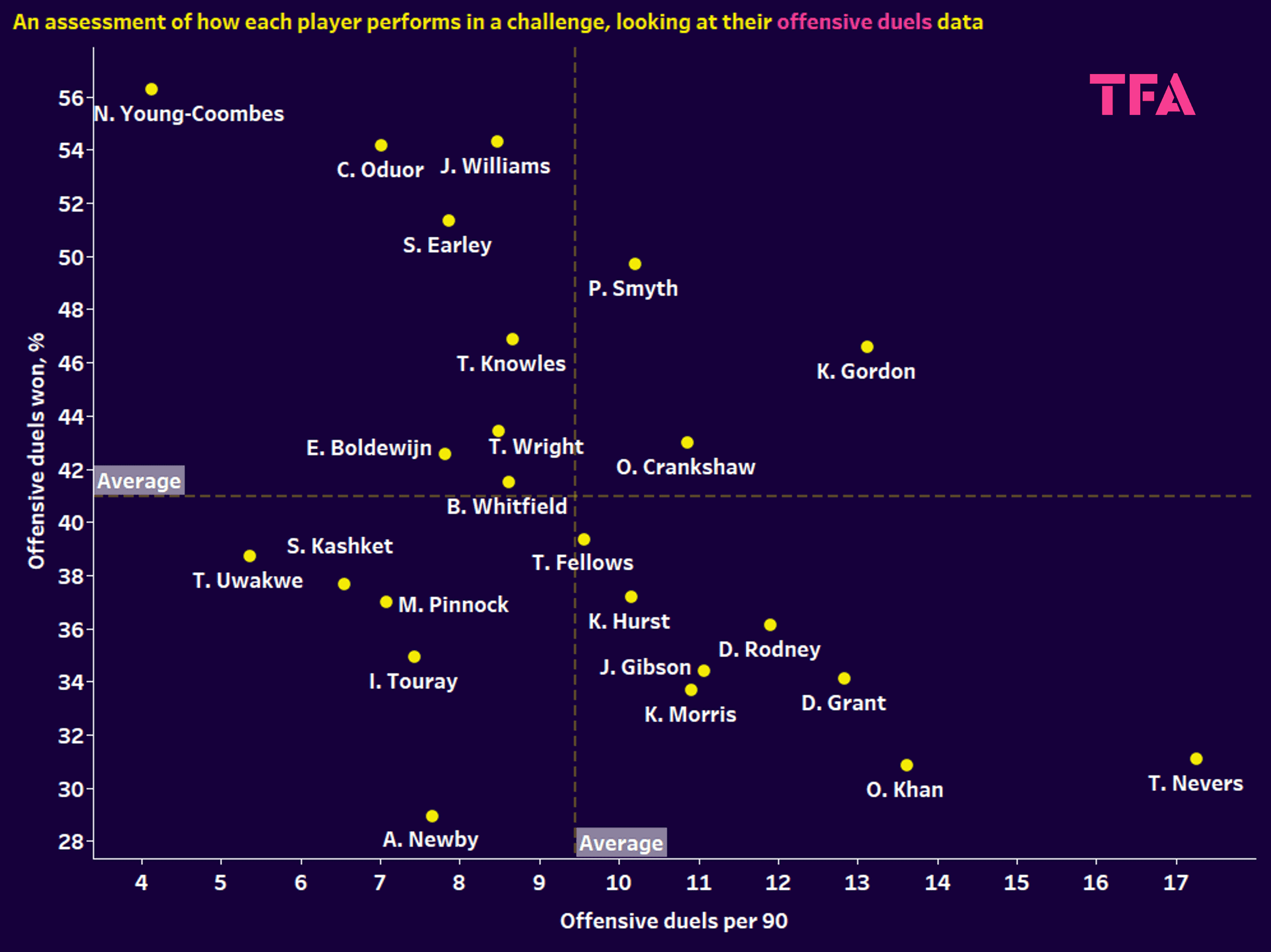
We start with an analysis of offensive duels. Wyscout defines this as “a ground duel for the player in possession” – essentially defending/keeping the ball when a challenge from an opponent comes in. Depending on where your eyes go first, a cluster of names pops out. Thierry Nevers (Newport County) averages the most offensive duels per 90 minutes (17.26) yet has one of the lowest offensive duels win rates (31.07%).
If you were drawn to the top of the graph first instead, you will have noticed more names quickly. While it could be argued that Nevers has a low win rate purely because he gets involved in so many offensive duels, the opposite could be said of Nathan Young-Coombes (AFC Wimbledon). Our data tells us that Young-Coombes has won 56.25% of his offensive duels (the highest of the bunch) yet averages less than anyone else on the list.
In terms of being more effective/being better than the group average, three names appear in that top right corner box. Paul Smyth (10.2 & 49.69%) is there again – get used to seeing his name! Kellan Gordon of Mansfield (13.13 & 46.59%) makes an appearance from right-back/right wing-back, being the Stags’ wide outlet on the right flank. Ollie Crankshaw of Stockport County (10.86 & 43%) completes the trio.
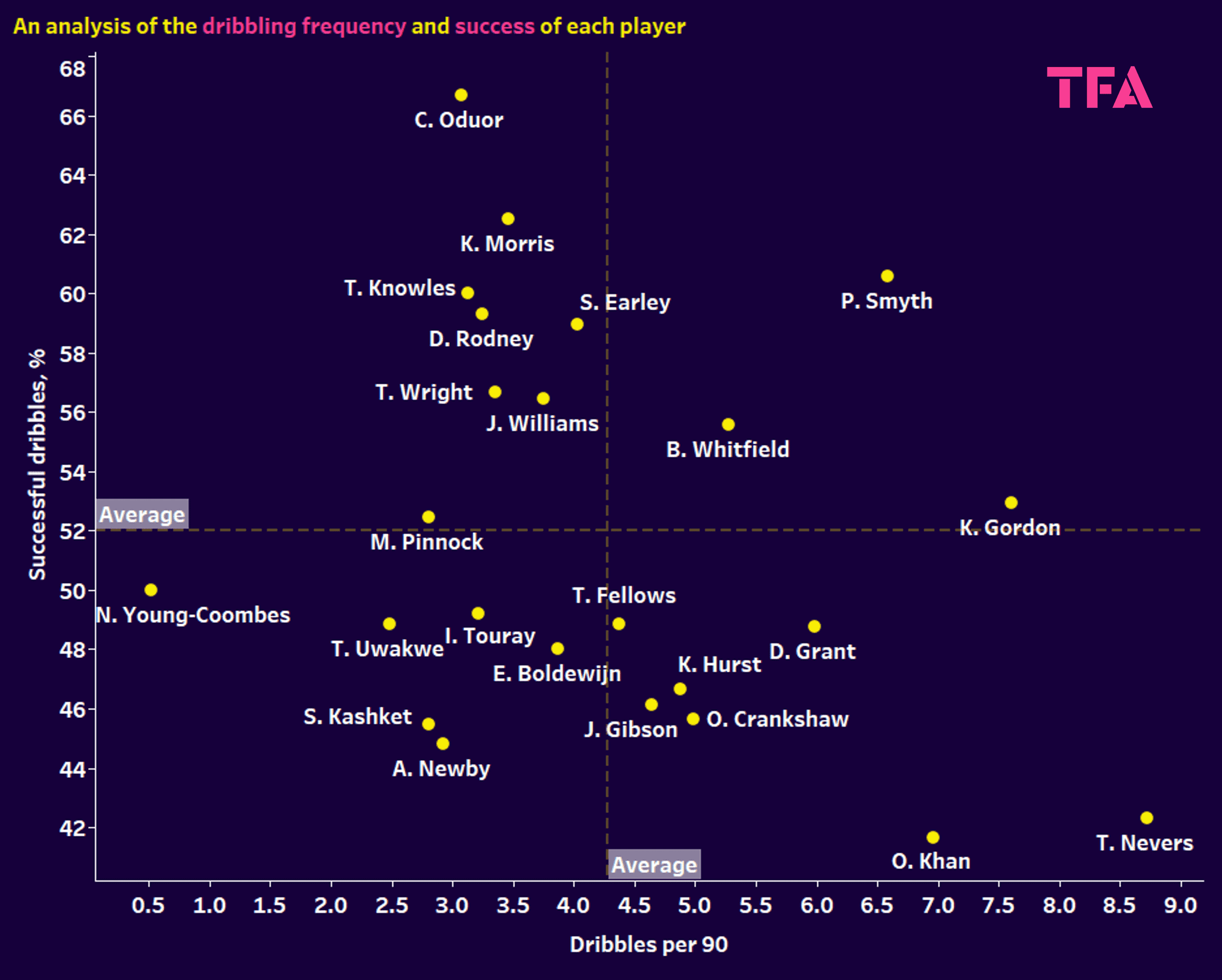
The scatter graph above lets us drill down to the bedrock of a winger’s primary purpose, their ability to dribble, looking at their average number of dribbles per 90 next to their dribble success rate.
Nevers finds himself in a familiar situation as the previous graph – plenty of dribbles 8.72, but a low success rate of 42.31%. While his success rate may look poor at face value, that is still 3.68 successful dribbles per 90 – more than enough potential for danger in those numbers.
Clarke Oduor has demonstrated an ability and reliability in dribbling. While he only averages 3.07 dribbles per 90 for Hartlepool United, he has a strong success rate of 66.67% – the highest of the whole group actually. There are two sides to this coin. While this means he is successful with a healthy amount of his dribbles, ergo losing the ball fewer times, he only averages 2.04 successful dribbles per 90 – would you rather have someone who dribbles less but more efficiently but offers a lower frequency, or someone who offers more successful dribbles with a higher risk of losing possession?
Meanwhile, Gordon, Crankshaw, and Whitfield all fall into the top right corner box again, indicating that they are once again higher than average across both metrics.
Passing
The modern game often requires players in every position to be comfortable on the ball and reliable in their passing, and wingers are no exception. If anything, passing, in its many forms, is one of the most important traits of a winger as many goal-scoring opportunities come from wide areas. In this final segment, we will analyse the passing range of each player – looking at key statistics that highlight their comfort on the ball but also their ability to contribute to attacking phases with passes.
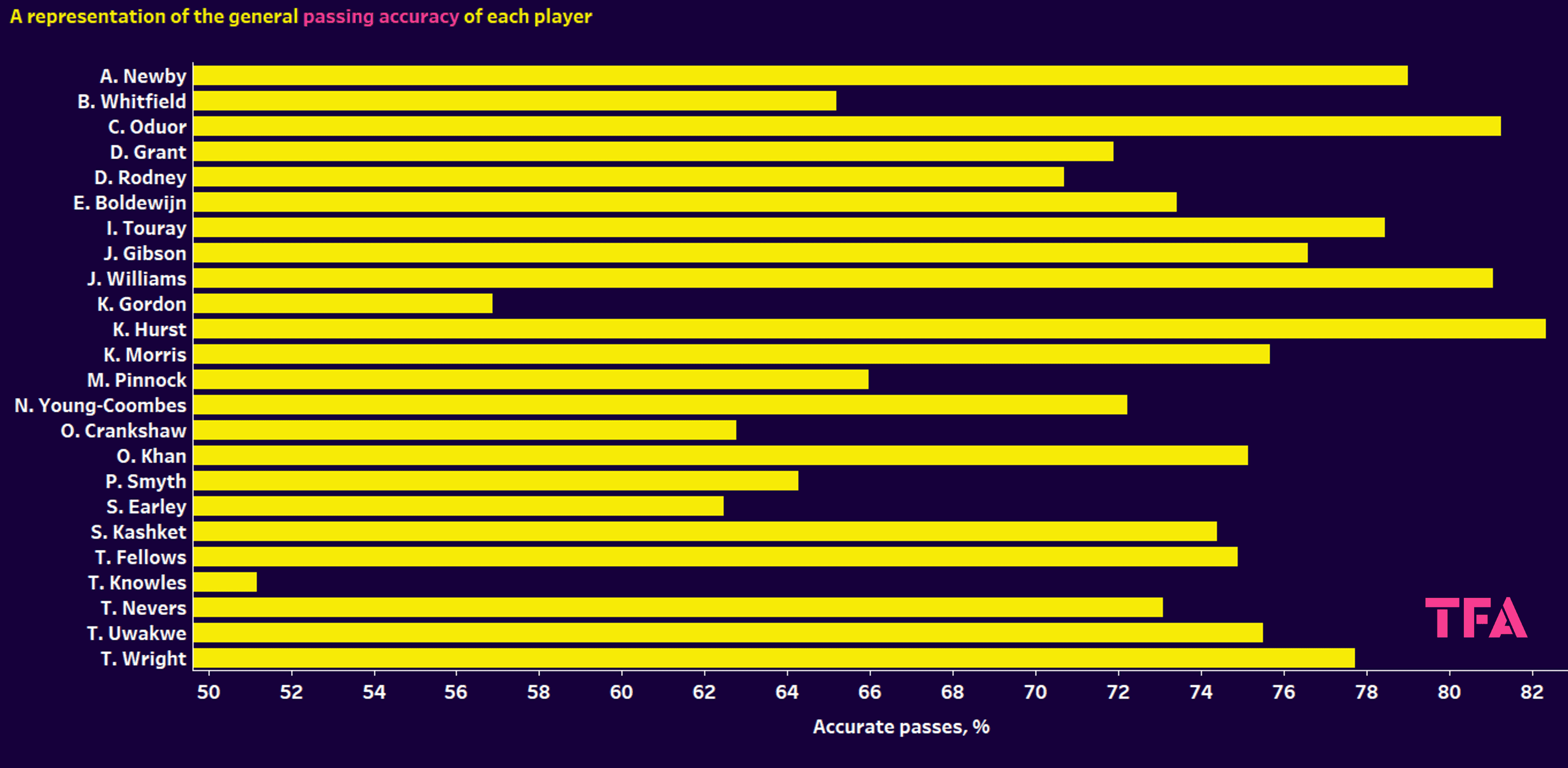
This first bar chart just gives us an idea of which players have a natural ability in overall passing – including short passes, long passes, backward passes, and so on. A selection of players jumps out at the top of the chart. Williams (81.04%), Oduor (81.25%), and Alex Newby (79%) are some names. However, it is Kyle Hurst of Doncaster who boasts the highest of the group with an admirable pass accuracy of 82.33%. This may link to Doncaster’s style of play and formation as well as Hursts’ ability as they look to form links between their wingers and wing-backs in times where they control possession in the opposition half.
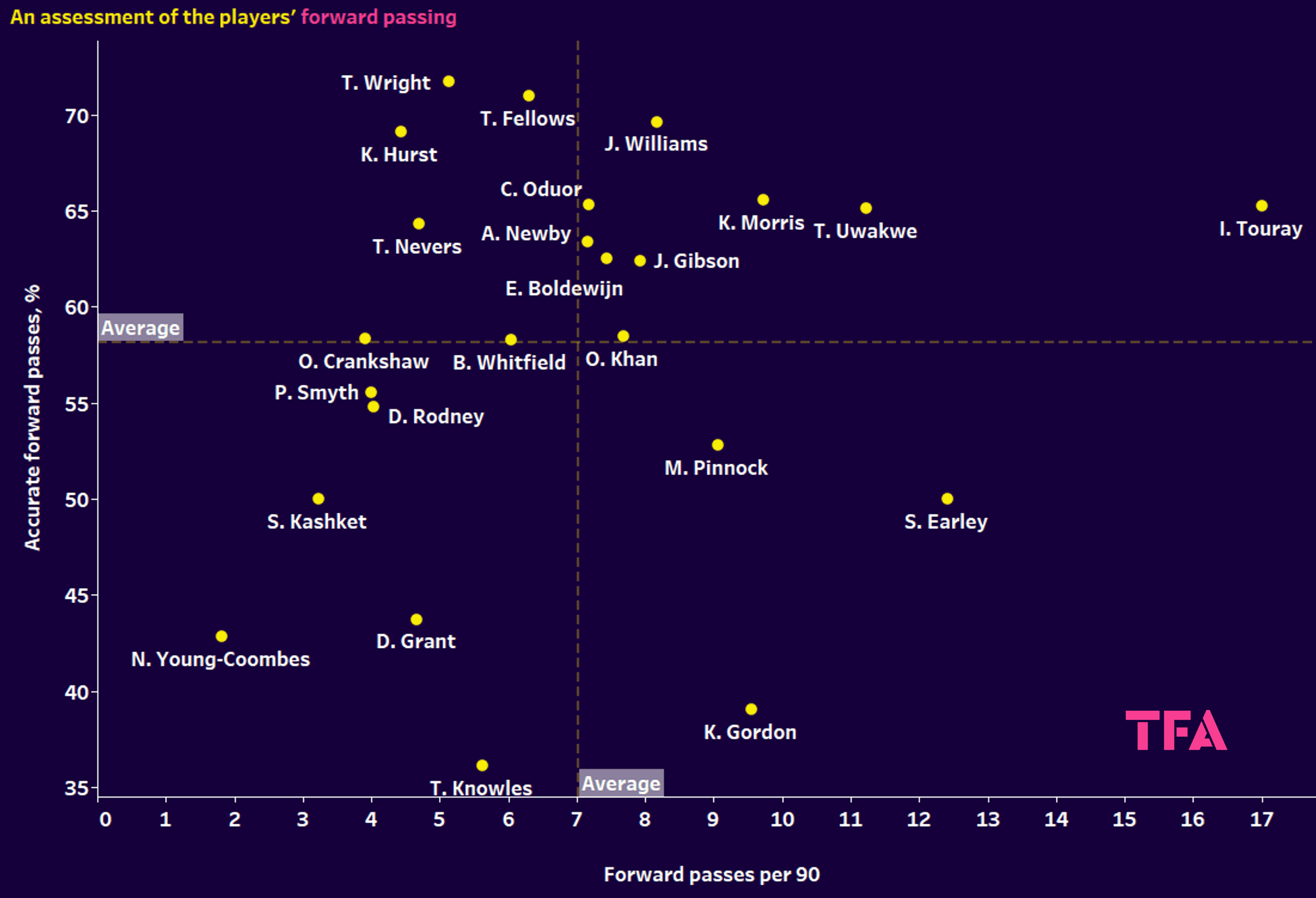
Moving on, we look at the ability of forward passing. Context is important, as always: analysing the forward passing of a central defender will have an entirely different angle and purpose than analysing forward passes made by wingers. Due to the attacking nature of a winger, a lot of their forward passes will be into strikers or advanced midfielders, often into high areas of the pitch.
Wright pops back up, this time thanks to his high forward pass accuracy of 71.74% but ranks lower on the average number of forward passes made. A number of names appear in the famed top right corner box, but one name in that zone jumps out – Ibou Touray of Salford City. The left wing-back has the highest average amount of forward passes per 90 (17.01) and has a strong accuracy rate to go with it (65.27%), indicating that he is a dangerous presence on the ball and should not be afforded the space to pick out his pass.
In terms of reoccurring names, Williams is there again thanks to his high average across both metrics, while Hurst has one of the higher forward pass accuracy rates despite his low average amount.
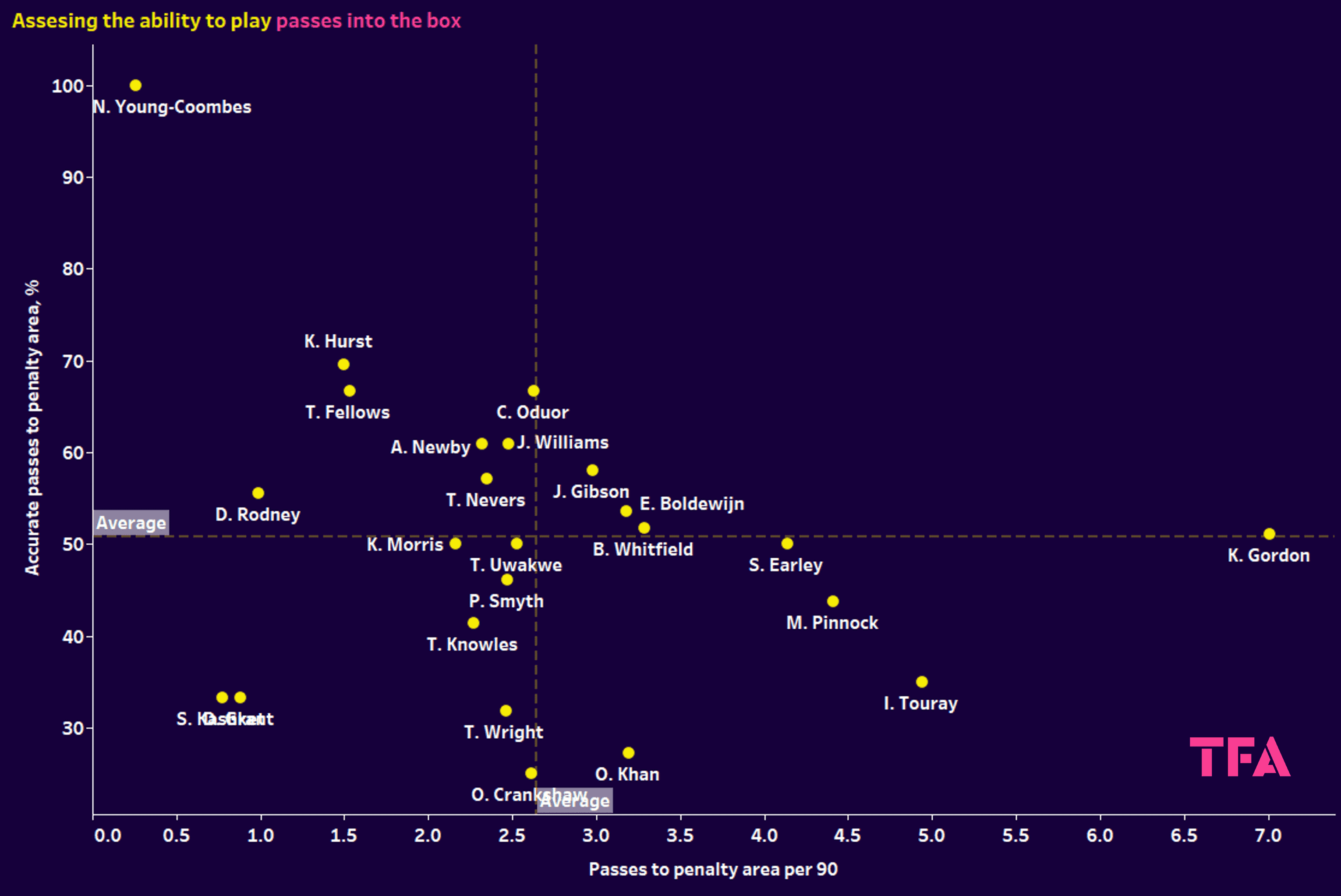
This penultimate graph is an extension of the previous analysis, if not a more zoomed-in version of the previous set of data. While that looked at forward passes, this looks exclusively at passes into the penalty box. We’ll keep this part short and sweet as it offers strong similarities to the previous graph, and you’ll notice that some players appear in the same region of the graph.
Young-Coombes seems to be in the business of few attempts but high success. Averaging 0.26 passes into the area per 90, he might think about getting more involved with this thanks to his 100% accuracy rate. Kellan Gordon impresses again, creeping his way into the top right corner box with his high amount of passes into the box (7.01): his good accuracy rate of 51.06% suggests that he a threat from wide areas and can provide opportunities on a consistent basis.
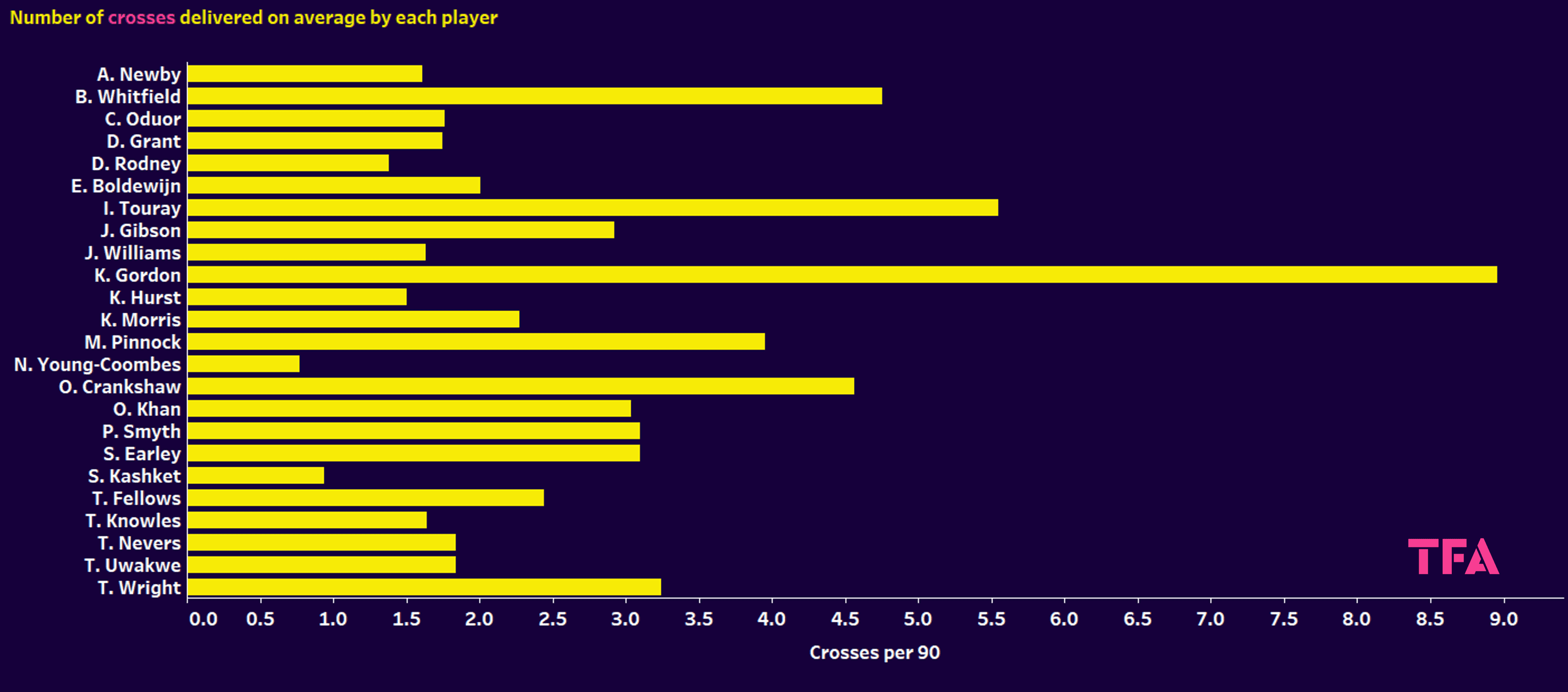
We’ve saved the most winger-like attribute to last: crossing. For many teams, crossing is a vital part of their attacking approach as they may have a target man anticipating a good delivery. This final graph looks at the number of crosses made by each player on average as this could highlight their confidence to do so, as well as the positions they get into. The reason behind the exclusion of crossing accuracy data is that this action more than any other heavily relies on the positioning and reaction of teammates and opponents – sometimes an absolute peach of a cross will result in nothing thanks to an attacking teammate failing to meet it.
Kellan Gordon stands out once more with an average of 8.96 crosses per 90, a phenomenal amount when you think about it. He has two assists in total, a number which is likely supported by, and likely to increase thanks to his tendency to cross regularly.
Touray shows a hunger to get balls into the box as well, averaging 5.55 crosses per 90 from either left-back or left wing-back, while Whitfield and Crankshaw also have above-average (compared to the group) numbers.
Conclusion
Hopefully, this data analysis of League Two wide players has given you some insight into the ability in wide areas in the division. It has also thrown up some names that are worth monitoring as they look to have talent in one area or another.
There were some standout players from the various graphs. Kellan Gordon of Mansfield looks to have an important role in his side’s system, offering both attacking and defensive factors. Ben Whitfield has been in fine form so far this season and he also looks to be an excellent team player who has an eye for a pass. There are several other names who have demonstrated an ability to play in wide areas – even more reason to watch or follow League Two football!

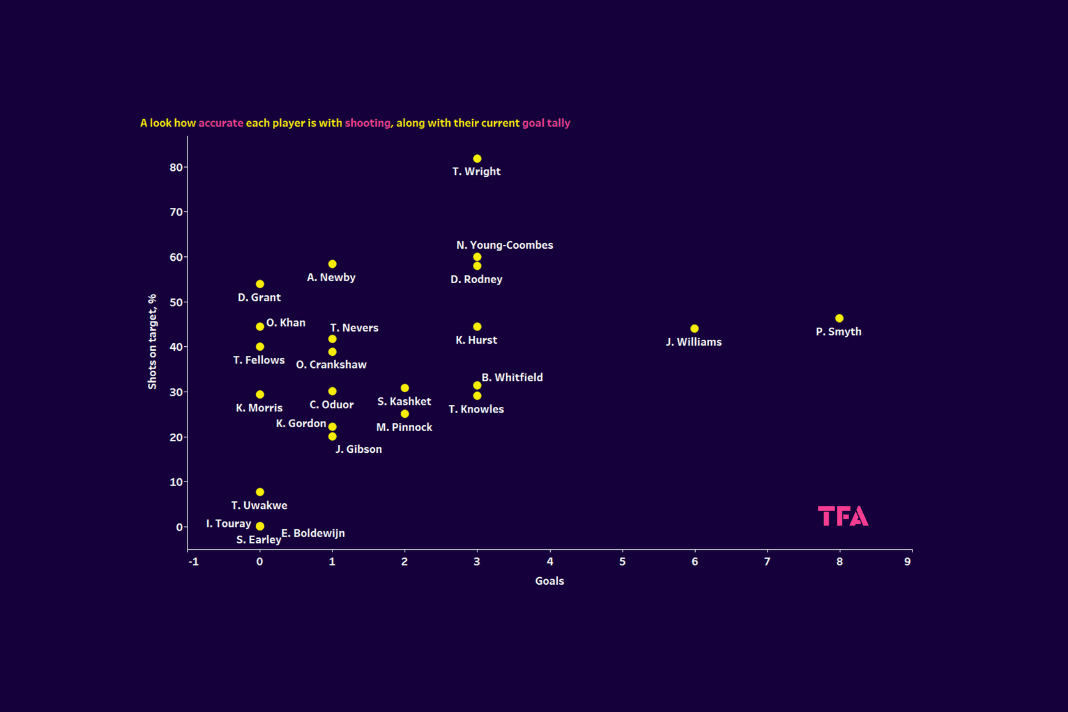




Comments